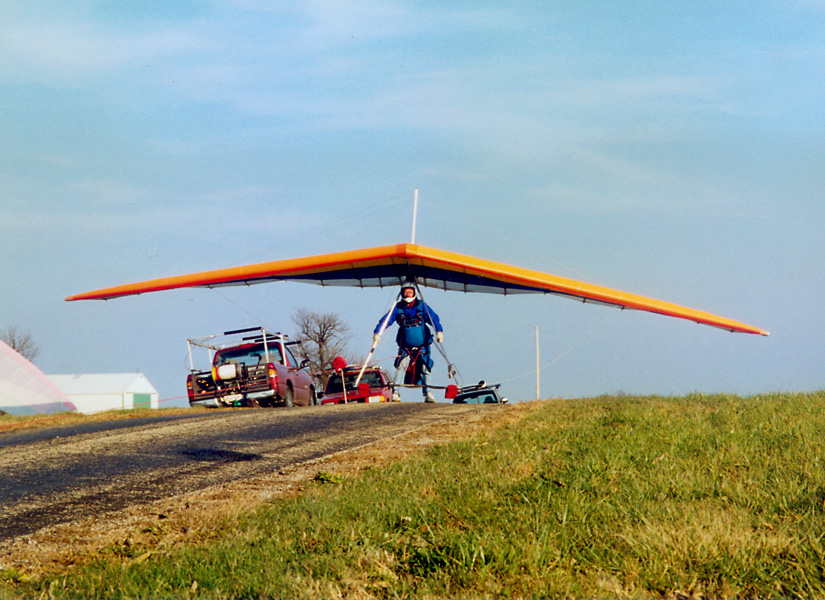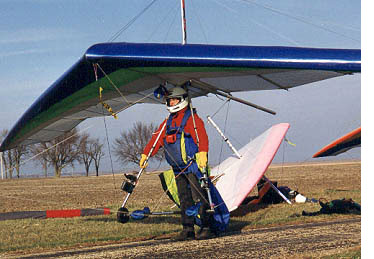

Compared to other forms of launching a hang glider, static towing is like riding a rocket ship to 2000+ feet. Because of the "false gravity" supplied by the truck through the towline, it's really quite amazing to step off flat, level ground and into the air. The foot launch starts with resisting the tow force before haltingly going along with the pull to assure most stretch is out of the towline. Climbing at a high angle of attack - at times climbing near 1400 feet per minute, bumping the bar to correct, topping out, releasing the towline and wrapping up the bridle... WOW! In two minutes, we've gone from standing to free flying.
Standing at launch for my first tow, looking straight ahead down the towline, I barely noticed my wing. Told the observer, "GO! GO! GO!" The sensation for this aerotow pilot was quite unique. I felt more like Superman in stepping off the ground and then in the prone position. In almost no time I was above 2000 feet and flying free.
- Gary S
Driving the tow vehicle is unique, too... space here doesn't permit a full explanation on all the details, but let it be said that you've never driven quite this way for any reason (see TowDriver SOP). The driver watches ONLY a pressure gauge and varies the speed of the car to maintain a constant tension. Every tow team has horror stories of what can happen when the driver does not watch the gauge. (Maybe some day we'll have those stories on a separate page)

Our style of introducing pilots safely and successfully to static line towing is a 2-day process (usually). Our ideal process starts on Day 1 when you show up at a site without your glider. You'll learn all the elements - including the teamwork - that's necessary for a good towing system: the towing hardware, the vehicle use and driving, radio usage on the ground as well as hearing pilots in flight, weaklinks, towline, and other equipment du jour. This may seem elemental, but we've found it the best way to start.
 Maybe a week or more later on Day 2, you'll set up early in the morning for your first tow after a review of the details. It'll be a smooth, light wind day with no thermals or turbulence to interfere with that first flight. After several successful tows in real calm conditions, you may be allowed to tow in increasingly turbulent conditions.
Maybe a week or more later on Day 2, you'll set up early in the morning for your first tow after a review of the details. It'll be a smooth, light wind day with no thermals or turbulence to interfere with that first flight. After several successful tows in real calm conditions, you may be allowed to tow in increasingly turbulent conditions.
Pilots whose skill and ability is known to the "coaches" have been allowed to tow on Day 1, but that is not the norm. We've seen some pilots have problems that could have lead to disaster. Others have done just fine. And there is no way for us to know beforehand who can do what. Therefore, your patience is required while we, or any instructor, get to know you and your ability.
NEXT PAGES:
General overview
Parts of the system
Bridle info
Driver info
Towing criteria
Linknife Static Tow

Aerotowing is probably the best way to get introduced to hang gliding, and for an experienced pilot it can be an awesome way of getting airtime. Beginners fly tandem with an instructor after the ground school session and actually fly the glider on their first flight from about 3000 feet above the ground. At Whitewater WI, on most any day pilots are carving up the sky. Pilots launch from a 3-wheel dolly with 200-250 feet of line connecting them to the tug plane, then release (usually in a thermal) at 2000-2500 feet.
Check the other pages if this interests you. Your comments are welcome, as is your friendship and teamwork at the sites. LET'S FLY!!!
DISCLAIMER: As with all aviation endeavors, your choice and use of equipment is totally up to you. It is assumed you are an experienced HG or PG tow pilot who is intimately familiar with the style of towing you will be doing. As such, YOU ASSUME ALL RISK AND LIABILITY in the use of the Linknife, as well as all other parts, functions and personnel involved in the towing and flight operations. If you do not have experience in towing, please contact an instructor for expert training. Trying to learn on your own can, and probably will, result in your injury and even death. Many pilots have paid the ultimate price so we may now tow as safely as never before possible. Please learn from their lessons.
Linknife Home | Static Line | Payout/Platform | Aerotow | Testimonials
Reel Pilots Home |
Hewett's Towing Criteria |
Driver SOP
Static Line Basics |
Static Towing Parts |
Hewett Bridle Basics
Parachutes |
Lockouts |
Payout Primer |
Flying Sites
Links clubs/info |
Links2 states/countries
Airshow |
Site Opening Primer
Birren Design Company | Site Map
©2000-2023 Peter Birren email
Powered by w3.css